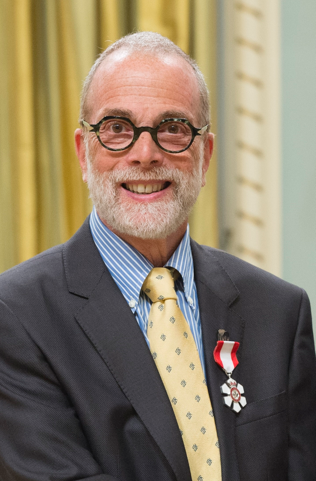Released in April 2018, this is the final of three Difference Makers Discussion Papers CAMH and our presenting partner, Morneau Shepell, are releasing to continue to engage Canadians in a national conversation on mental health leading up to the May 23, 2018 Difference Makers Symposium.
There are a number of exciting innovations making a difference in the lives of the many Canadians impacted,
directly or indirectly, by mental illness each year. We need more. We need to work together to identify
and scale what works, as well as support the discovery and development of new approaches to fill
remaining gaps.
In the fall of 2017, we celebrated a number of CAMH Difference Makers who introduced us to innovative
ways of working together, and new approaches for meeting the needs of people living with mental illness,
including addiction. Their stories revealed that:
Innovative practices are often slow to be scaled up, even when a solid evidence base exists, due to a lack of adequate resourcing.
Internet-based interventions have the potential to significantly increase access to care. They also raise new possibilities around the ownership and use of users’ health data for monitoring outcomes.
Integrated service experiences can reflect the person-centred needs of those living with mental illness who often require access to multiple social services in their recovery journeys. The partnership development needed to facilitate these connections requires resourcing beyond simply supporting the co-location of services.
The stories of these Difference Makers who have helped to push boundaries in the development and spread of innovative interventions point us to where more resources are needed in order to create a mental health care system and society that is set up to meet the current and emerging needs of Canadians.
Scale what we know is working, faster

Steve Lurie
“Many community-based programs such as housing first, supported employment, and peer and family support are evidence based and have produced outcomes that include improved quality of life, employment, housing stability and reduced isolation, as well as reducing the need for hospitalization. For example . . . the Mental Health Commission of Canada’s housing first study (At Home / Chez Soi) showed that every $10 invested in housing first services resulted in an average savings of $9.60 for high needs participants and $3.42 for moderate needs participants. These services should be scaled and readily available across Canada if we are serious about improving our mental health systems.”
Steve Lurie, CAMH Difference Maker and Executive Director of Canadian Mental Health Association Toronto
Maximize the potential of internet-based platforms
In the second Difference Makers Discussion Paper we explored the need for dialogue and action around the creation of mentally healthy online spaces. We recognized that for some, the emerging norm of constant connectivity came with potentially negative impacts. However, for those for whom digital communication is more comfortable, or those who experience geographic or social barriers to accessing in-person services and supports (such as those living in rural / remote settings or people living with mobility limitations), internet-based platforms represent a promising new opportunity for accessing care.4
Telepsychiatry is a real‐time consultation by a psychiatrist to a client via secure videoconferencing, allowing treatment to occur when the psychiatrist and patient are located in different geographic locations.
Morneau Shepell has a student support app provided in partnership with some post-secondary institutions. Recent utilization data reveals that:
The growing comfort with online health platforms is not restricted to youth.
The introduction of publicly-funded ICBT is emerging to varying degrees across provinces and territories.
The MHCC’s 2017 scan10 of initiatives across Canada, along with its guidance11 to users considering accessing the growing number of free, paid and publicly-funded internet-based mental health services points to the need for continued knowledge building among users, service designers and service deliverers given the emergent nature of these offerings.
As exciting as the opportunity to leverage internet-based platforms to connect more Canadians to care is, so too is the opportunity for shared learning as service users, designers, deliverers and providers (including governments) dive into exploring this rapidly emerging platform simultaneously.

Dr. Badri Rickhi
“Canada and other international health providers are encouraging the growth and delivery of e-health programs. They empower and educate people, provide insight into their own health which they can share with healthcare providers and informal caregivers. Current research shows lower administrative burden, quicker access for all, particularly for the elderly and rural populations.”
Dr. Badri Rickhi, CAMH Difference Maker and founder of CINIM
Increased access to person-centred, integrated care requires an investment in partnership development
Treating each client as a whole person, co-locating services, aligning eligibility requirements to make it easier for people to access the range of health and social services they might need to support their recovery journeys - these are some of the activities and outcomes referenced when the value of person-centred, integrated care is discussed. While it may not be realistic that one practitioner, service site or even system will meet all the needs of each person they serve, the need to do better has led to some exciting care model innovations and pointed to the critical role of partnership development.
Several initiatives are currently testing a similar model of integrated service delivery for youth across Canada, with project leads collaborating on shared evaluation approaches to build knowledge on impact and scalability.
Difference Maker Dr. Kathryn Dong grew frustrated as a downtown Edmonton emergency room physician treating the same patients repeatedly by addressing only their immediate physical health concerns and discharging them without addressing their other health and social service needs (mental illness, including addictions, precarious housing or income instability, for example). She leveraged research project funding to develop the Inner City Health and Wellness Program and within it the Addictions Recovery and Community Health Program. In addition to developing multiple community partnerships to provide emergency room patients experiencing mental illness with access to a range of services, the program includes a peer support component. The engagement of past clients in this role has been essential to supporting patients to feel truly seen and heard. Watch this video to learn more about the impact of the initiative.

Maureen Bilerman
"I believe that the success of any integrated service delivery approach depends upon our ability to empower youth, family and community members to work in partnership with service designers and deliverers. Otherwise we run the risk of merely recreating a more coordinated version of the status quo. Imagine if the mental health care systems we have now were integrated into the systems of care we inherently occupy from birth those provided by families, neighbours, school staff and community supports. Now that would be transformation!"
Maureen Bilerman, CAMH Difference Maker and founder of Dots NB
Scale what we know is working, faster. Maximize the potential of internet-based platforms. Invest in partnership development including client and family engagement in order to truly capitalize on the potential of person-centred, integrated service delivery models. Let's ensure these and other lessons are remembered and utilized as individuals, communities and governments at all levels look to advance existing and new innovations to help us better meet the needs of the one in five Canadians who experience mental illness each year.
Be sure to also read our first Difference Makers Discussion Paper exploring Inspiration through stories of stigma being broken down and the pockets of hope created when individuals get easy access to appropriate care. Also check out our second Discussion Paper, on Connection. It explores what each of us can do to create more mentally healthy spaces where we live, learn, work and play - check these others papers out and join the conversation to create a more mentally healthy Canada!
1Goering, P., Veldhuizen, S., Watson, A., Adair, C., Kopp B., Latimer, E., Nelson, G., MacNaughton, E., Streiner, D., Aubry, T. (2014). National At Home/Chez Soi Final Report. Calgary, AB: Mental Health Commission of Canada. Retrieved from https://www.mentalhealthcommission.ca/sites/default/files/mhcc_at_home_report_national_cross-site_eng_2_0.pdf
2Lawrynuik, Sarah (2017, January 26). Medicine Hat Maintaining Homeless-free status 2 years on. CBC News. Retrieved from http://www.cbc.ca/news/canada/calgary/medicine-hat-homeless-free-update-1.3949030
3 https://www.mentalhealthcommission.ca/sites/default/files/2016-11/national_at_home_sustainability_report_eng.pdf
4Mental Health Commission of Canada (2014). E-Mental Health in Canada: Transforming the Mental Health System Using Technology. Mental Health Commission of Canada. Retrieved from: https://www.mentalhealthcommission.ca/sites/default/files/MHCC_E-Mental_Health-Briefing_Document_ENG_0.pdf
5Crawford, A., Serhal. E., Rodie, D. (2018, January 31). Increasing access to integrated mental health care support closer to home. CAMH Blog. Retrieved from: https://www.camh.ca/en/camh-news-and-stories/to-2016/increasing-access-to-integrated-mental-health-care-support-closer-to-home
6“The kids aren’t alright: It’s time to get serious and invest in student mental health” (2018, March 15). The Globe and Mail [Editorial]. Retrieved from https://www.theglobeandmail.com/report-on-business/careers/leadership-lab/the-kids-arent-alright-its-time-to-get-serious-and-invest-in-student-mental-health/article38281411/
7Ibid.
8HMorneau Shepell (2017). Annual utilization trends.
9Mental Health Commission of Canada (2017). e-Mental Health Project to Improve Access to Mental Health Services in Newfoundland and Labrador and Lead the Way Nationally. Retrieved from https://www.mentalhealthcommission.ca/English/e-mental-health-project
10 Mental Health Commission of Canada. (2017). Advancing the Evolution: Insights into the State of E-Mental Health Services in Canada. Retrieved from https://www.mentalhealthcommission.ca/sites/default/files/2017-08/eMH%20Environmental%20Scan_FINAL%20EN.pdf
11 Mental Health Commission of Canada (2016). Mental Health Apps: How to Make an Informed Choice. Retrieved from https://www.mentalhealthcommission.ca/sites/default/files/2018-01/eMH_app_eng.pdf
12 Ibid.
13 Access Open Minds (2017). “Access Open Minds: Project Overview.” Retrieved from http://accessopenminds.ca/wp-content/uploads/2016/06/ACCESS-Open-Minds-Project-Overview.pdf